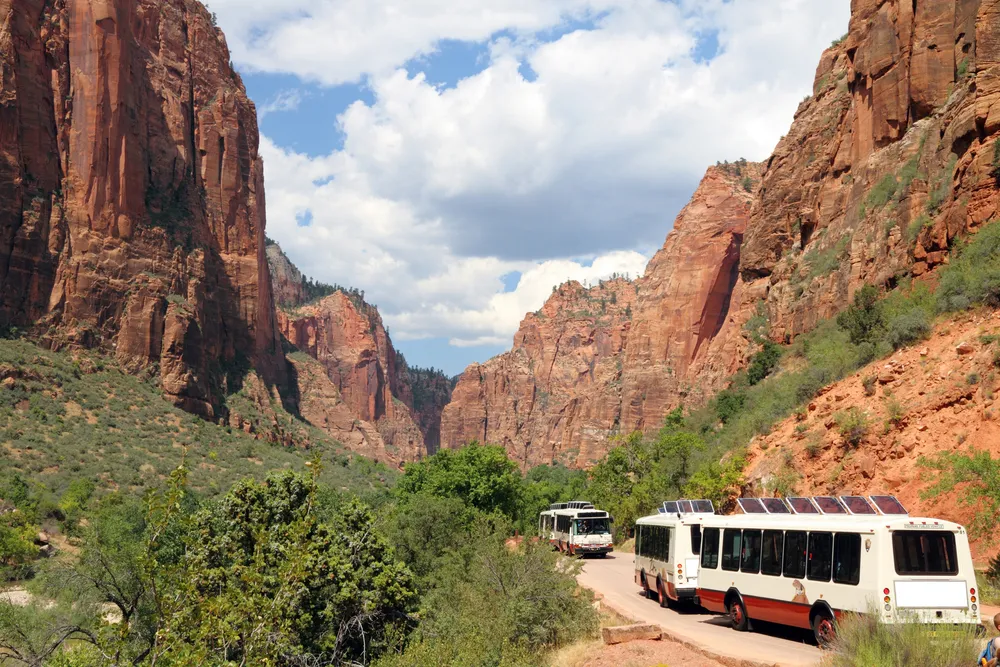Hey there, fellow Zion enthusiasts! If you're planning a trip to the breathtaking canyons of Zion National Park, one of the most crucial things to understand is the Zion National Park shuttle schedule. Trust me, navigating Zion without knowing the ins and outs of the shuttle system is like trying to hike The Narrows without proper footwear – you'll get somewhere, but it won't be pretty, and you'll miss out on a lot of the magic!
I've been to Zion countless times, in every season, and I've experienced firsthand how this shuttle system, while sometimes a bit of a puzzle for first-timers, is an absolute blessing. It's designed to protect the park's delicate ecosystem from vehicle congestion and pollution, while also ensuring everyone gets a fair chance to experience its wonders. So, if you're wondering about the best way to get around, how often the buses run, or where exactly they'll drop you off for your next epic hike, you've come to the right place. I'm here to share my personal tips and detailed insights to help you master the Zion shuttle and have a stress-free, unforgettable adventure.
When the Shuttle is in Operation?
This is probably the first question on everyone's mind, and for good reason! The Zion Canyon Scenic Drive, which leads to many of the park's most iconic trails and viewpoints, is only accessible by shuttle for most of the year. Private vehicles are generally not allowed on this road when the shuttle is running, unless you have a reservation at the Zion Lodge.
Operating Schedule:
From my experience and based on the park's typical operations, the shuttle usually runs daily from early March through late November. There's also often a special operating period during the winter holiday season (around late December to early January). Outside of these times, you might be able to drive your personal vehicle up the Scenic Drive, but always check the official National Park Service (NPS) website for the most up-to-date information, as dates can shift slightly each year due to weather conditions or operational needs.
For example, in 2025, the shuttle service is expected to begin on March 2nd. During peak season (typically from mid-May to mid-September), the shuttle starts running very early, often around 6:00 AM, with the last departure from the Visitor Center around 7:00 PM. During the shoulder seasons, the hours might be slightly shorter. Buses typically run every 5-10 minutes, especially during busy periods, so you rarely have to wait long. This frequent service is a huge relief, as it means less time waiting and more time exploring!
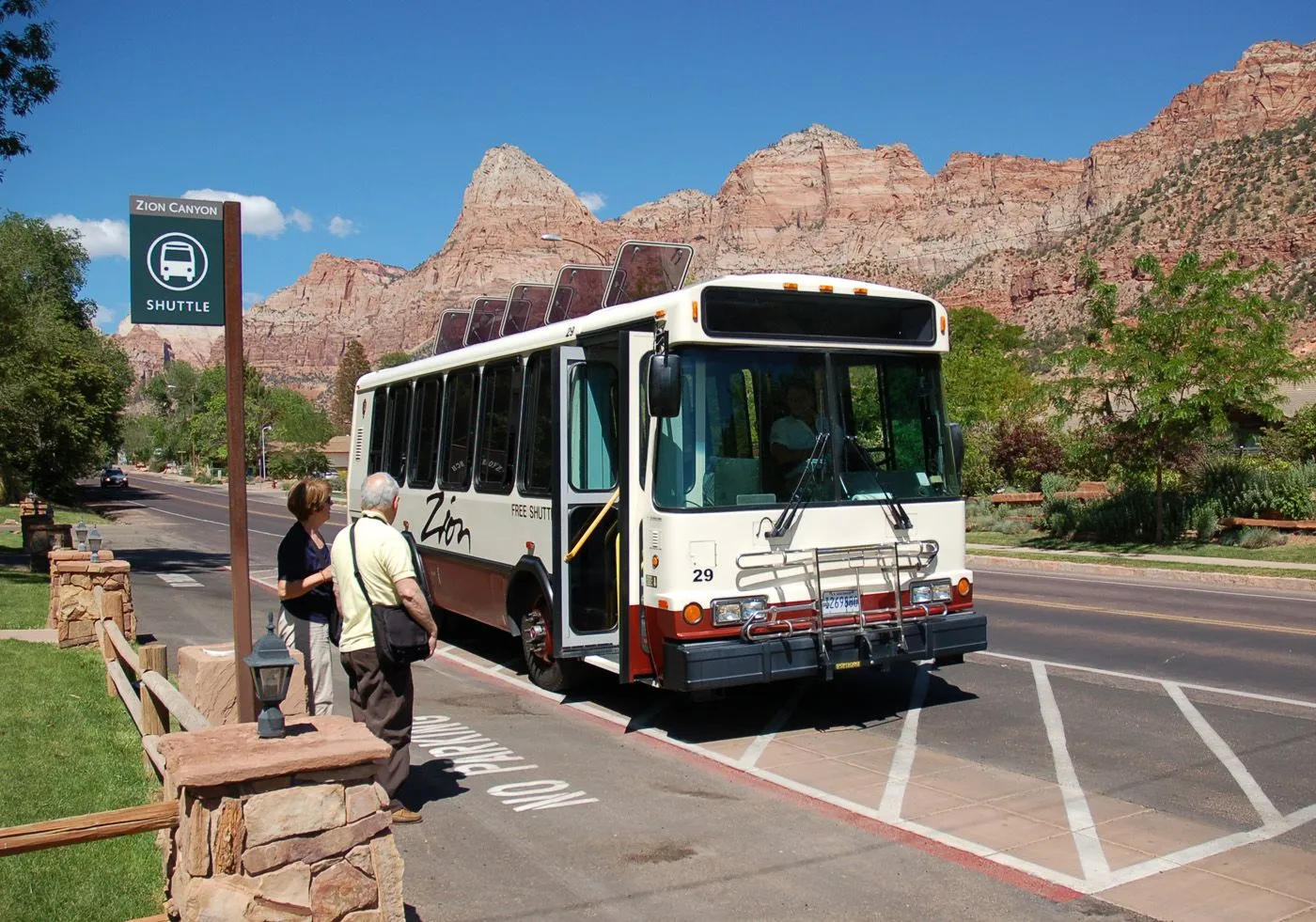
Why is the Zion shuttle a blessing?
Now, you might be thinking, "A shuttle? That sounds inconvenient!" And I get it, the idea of not being able to drive your own car everywhere can feel restrictive. But having experienced Zion both with and without the shuttle (back in the day, before it was fully implemented), I can tell you, the shuttle system is an absolute blessing for several reasons:
Environmental Protection
This is paramount. Zion National Park is a natural wonder, and the sheer volume of visitors was taking a toll on its delicate ecosystem. The shuttle significantly reduces vehicle emissions, noise pollution, and traffic congestion within the main canyon, helping to preserve its pristine beauty for generations to come.
Reduced Congestion
Oh, the parking! Before the shuttle, finding a parking spot in Zion Canyon was a nightmare, especially during peak season. Cars would line up for miles, and frustration levels were high. With the shuttle, you park once and then you're free to explore without worrying about moving your car or finding another spot.
Stress-Free Exploration
The shuttle allows you to sit back, relax, and truly soak in the towering cliffs, the Virgin River, and the stunning rock formations. The drivers often provide informative commentary, pointing out landmarks and sharing interesting facts, turning the ride itself into part of the interpretive experience.
Accessibility and Safety
The shuttle makes the park accessible to everyone, regardless of whether they have a car or are comfortable driving in unfamiliar mountain roads. With fewer private vehicles on the narrow canyon road, the risk of accidents is significantly reduced.
>> Read More: Where Is Zion National Park? A Detailed Travel Guide
How to use the shuttle system
Using the Zion shuttle system is surprisingly straightforward once you get the hang of it. Think of it as a hop-on, hop-off bus service for the park. Here's a step-by-step guide based on my numerous experiences:
1. Park Your Car
If you're driving, your first step is to park your car. The main parking area is at the Zion Canyon Visitor Center, just inside the park entrance in Springdale. This lot fills up very early, especially during peak season. If it's full (which it often is by 8 AM), you'll need to park in the town of Springdale and take the free Springdale Shuttle.
2. Enter the Park & Board the Shuttle
Once you're at the Visitor Center, you'll need to show your park pass or pay the entrance fee. The shuttle stop for the Zion Canyon Line is located just outside the Visitor Center. Look for the signs indicating the Zion Canyon Shuttle. The shuttles are large, comfortable, and designed to accommodate hikers with gear.
3. Know Your Stop & Hop On/Off
The shuttle makes nine stops along the Zion Canyon Scenic Drive. Each stop provides access to different trails, viewpoints, and facilities. You can get off at any designated stop, explore the area, hike a trail, take photos, and then simply wait for the next shuttle to come along and pick you up.
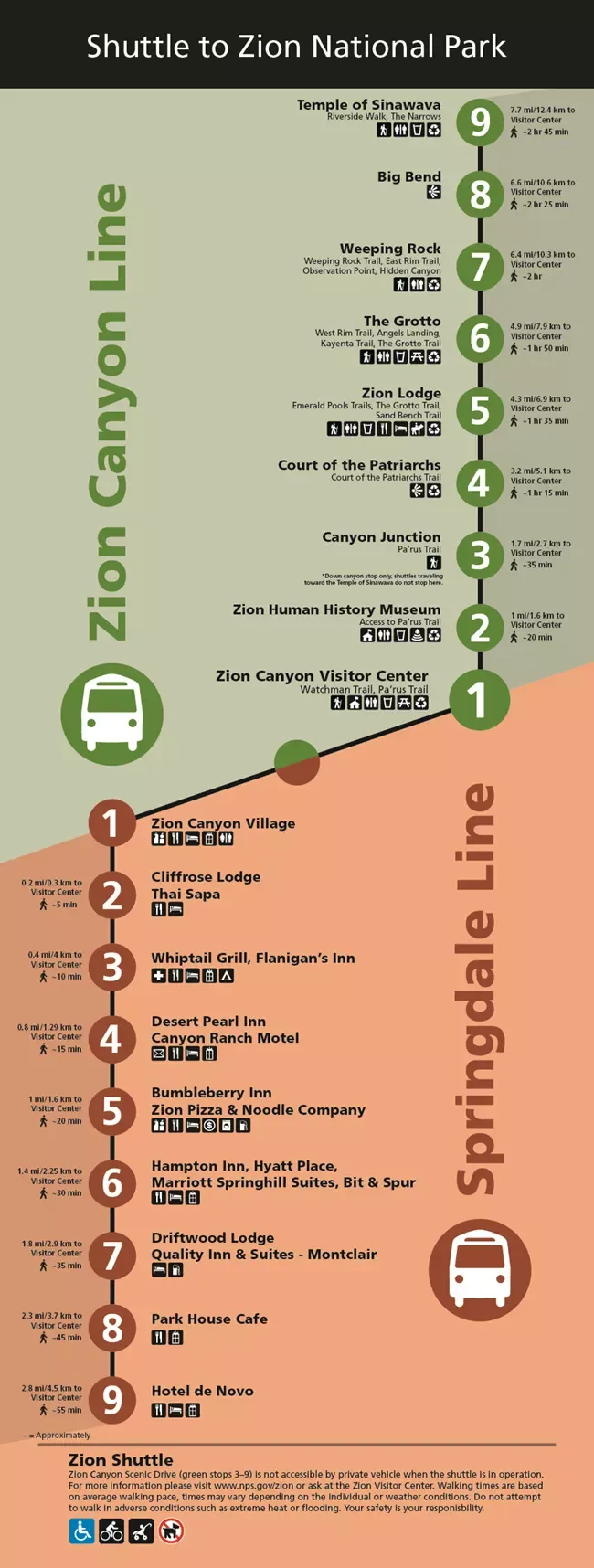
Shuttle Stops in Zion Canyon
The Zion Canyon Scenic Drive is approximately 6 miles long, and the shuttle makes nine designated stops along its route. Each stop offers access to unique trails, viewpoints, and facilities. Understanding what each stop offers is key to planning your day effectively.
1. Zion Canyon Visitor Center
What it offers:
Here, you'll find restrooms, a bookstore, a gift shop, and park rangers who can answer your questions and provide up-to-date information on trail conditions, weather, and shuttle schedules. It's also the main parking area for private vehicles and the transfer point for the Springdale Shuttle.
My Insight:
Always make this your first stop. Grab a map, check the current conditions, and fill up your water bottles. The rangers are incredibly helpful, and getting their advice can save you a lot of time and potential headaches.
2. Zion Human History Museum
What it offers:
This stop is home to the museum itself, which showcases the human history of Zion Canyon, from its earliest inhabitants to the pioneers and the establishment of the national park. You'll find exhibits on Native American culture, early settlers, and geological forces.
My Insight:
I highly recommend spending some time here, especially if you're interested in learning about the people who have called this incredible place home. It provides a deeper appreciation for the park beyond just its natural beauty.
>> Read More: 5 Best Cities Near Zion National Park: Ultimate Guide And Map
3. Canyon Junction
What it offers:
Canyon Junction is where the Zion Canyon Scenic Drive meets the Zion-Mount Carmel Highway. You can access the Pa'Rus Trail from here, which is a paved, accessible trail that follows the Virgin River. It's one of the few trails in the main canyon where bikes are allowed.
My Insight:
I often use this stop if I want a leisurely walk or bike ride along the Pa'Rus Trail. It's a beautiful, relatively flat walk that offers stunning views of the Virgin River and canyon walls, and it's a good place for a quieter experience.
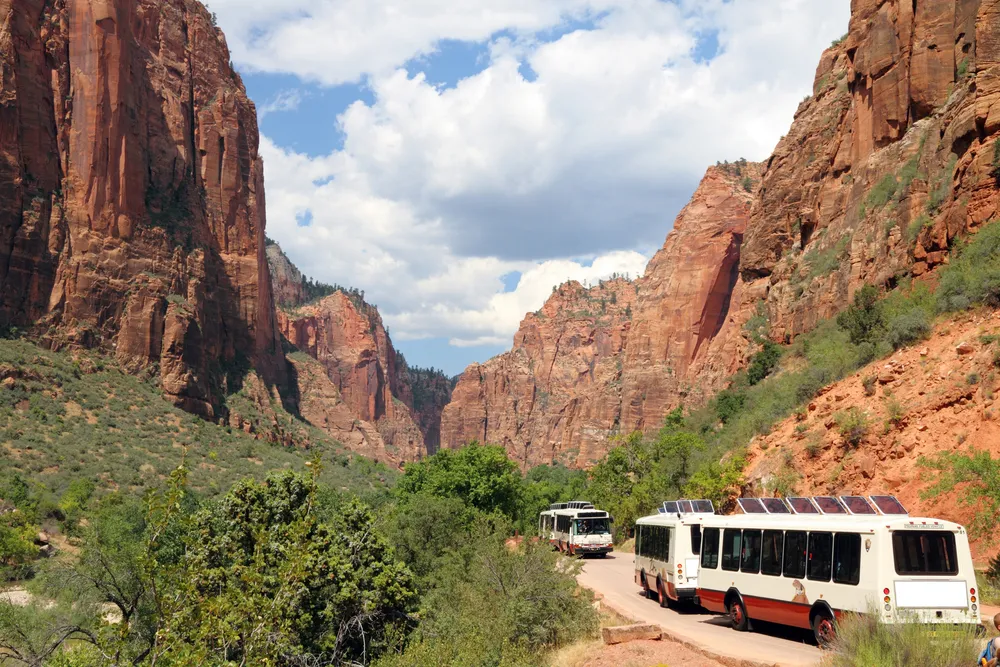
4. Court of the Patriarchs
What it offers:
A short, paved path leads to a viewpoint overlooking the Virgin River and three towering peaks named Abraham, Isaac, and Jacob. It's a popular spot for a quick photo opportunity and to admire the sheer scale of Zion's geology.
My Insight:
This is a great stop for a brief scenic interlude. It's not a hiking destination, but the views are spectacular, especially in the morning light. Perfect for capturing some classic Zion photos without committing to a long hike.
5. Zion Lodge
What it offers:
This stop provides access to the historic Zion Lodge, which features a restaurant, a cafe, a gift shop, and restrooms. It's also the trailhead for the Emerald Pools Trail, one of Zion's most popular and family-friendly hikes.
My Insight:
Even if you're not staying at the Lodge, it's a great place to grab a meal, use the facilities, or simply relax on the lawn. The Emerald Pools Trail is a must-do for many, offering beautiful waterfalls and lush vegetation.
>> Read More: The 12 Best Lodges Near Zion National Park: Where to Stay
6. The Grotto
What it offers:
The Grotto provides access to the West Rim Trail, which leads to the famous Angels Landing hike (permit required!) and Scout Lookout. You'll find picnic tables, restrooms, and a water filling station here. It's a beautiful, shaded area perfect for a break.
My Insight:
I've spent a lot of time at The Grotto, preparing for Angels Landing or just enjoying a picnic lunch. It's a hub for serious hikers, and the energy is always palpable. If you're planning to tackle Angels Landing, this is your stop.
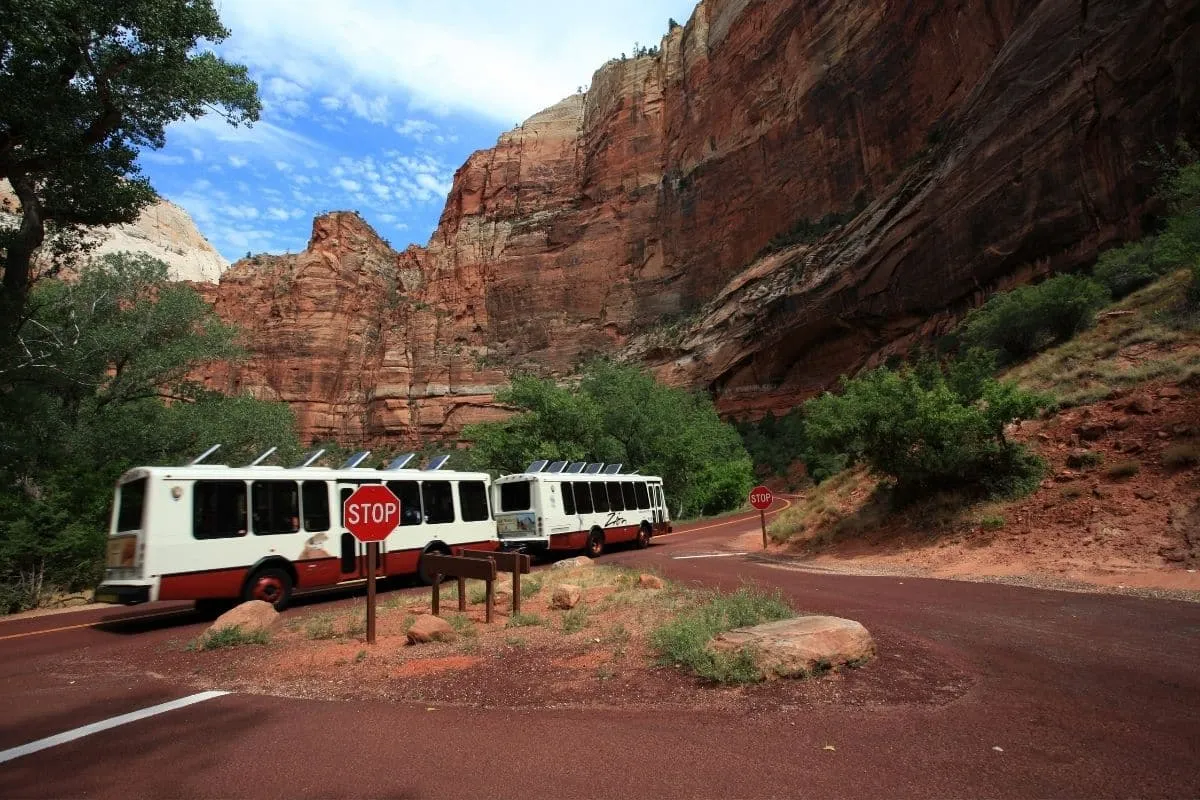
7. Weeping Rock
Note: As of my last update, the Weeping Rock trail has been closed due to rockfall. Always check the NPS website for current trail conditions before planning your visit.
What it offered (historically):
This short, paved trail led to a large alcove where water constantly seeps from the sandstone cliffs, creating a lush hanging garden. It was a beautiful, easy walk with stunning views of the canyon and the Virgin River below.
My Insight:
Weeping Rock was one of my favorite easy walks in Zion, especially on a hot day, as the constant mist from the weeping walls was incredibly refreshing. I sincerely hope this trail reopens in the future.
8. Big Bend
What it offers:
This stop is a large, open area with incredible panoramic views. It's a fantastic spot for photography, especially in the morning or late afternoon when the light plays beautifully on the canyon walls. You'll often see climbers on the cliffs from here.
My Insight:
I love Big Bend for its sheer photographic potential. It's one of those places where you can truly grasp the immense scale of Zion Canyon. If you're a photographer, don't skip this stop!
>> Read More: The 9 Best Resorts Near Zion National Park
9. Temple of Sinawava
What it offers:
This is the final and most popular stop, serving as the gateway to the famous Riverside Walk and The Narrows. A paved, accessible trail follows the Virgin River upstream to the mouth of The Narrows. There are restrooms and water filling stations available here.
My Insight:
The Temple of Sinawava is a truly magical place. The Riverside Walk is an easy, beautiful stroll, perfect for all ages. If you're planning to hike The Narrows, this is where your adventure truly begins. Be prepared to get wet!
Tips for a Stress-Free Zion Shuttle Experience
Arrive Early (or Late)
During peak season, the Visitor Center parking lot fills up before 8:00 AM. If you want to guarantee a spot, aim to arrive by 6:00 AM or 7:00 AM. Alternatively, arrive in the late afternoon (after 3:00 PM) when morning crowds have dispersed.
Utilize the Springdale Shuttle
If the Visitor Center parking lot is full, don't despair! The free Springdale Shuttle is your best friend. Park anywhere in Springdale and hop on the shuttle. It runs frequently and drops you right at the park's pedestrian entrance.
Pack Smart
Pack light but smart. Essential items include plenty of water, snacks, sunscreen, a hat, and comfortable hiking shoes. If you're planning to hike The Narrows, consider renting appropriate gear from an outfitter in Springdale.
Check Schedule Daily
The shuttle schedule can change, especially during shoulder seasons. Always check the official NPS website or the Visitor Center for the most current shuttle times and trail conditions, especially for the last shuttle departure.
Shuttle Buses in Zion National Park
The shuttle buses themselves are an integral part of the Zion experience. They are purpose-built vehicles designed to efficiently transport large numbers of visitors through the narrow canyon, minimizing environmental impact and maximizing visitor enjoyment.
Vehicle Features
The Zion shuttles are typically large, comfortable buses with open-air sections or large windows for excellent canyon views. They are designed to be accessible, with ramps for wheelchairs and strollers, and are quiet to maintain the peaceful atmosphere.
Frequency & Capacity
During peak season, shuttles run every 5-10 minutes. These buses are designed to carry many people efficiently. During busy times, they can get quite full, but rides between stops are relatively short, so even standing isn't for long.
Drivers & Commentary
Many shuttle drivers are incredibly knowledgeable and passionate about Zion. They often provide informal commentary during the ride, pointing out geological features, sharing historical anecdotes, and offering tips for enjoying the park.
Conclusion
Navigating Zion National Park can seem daunting at first, especially with the mandatory shuttle system, but as I hope I've conveyed, it's truly a system designed for the benefit of both the park and its visitors. The Zion National Park shuttle schedule is not just a timetable; it's a rhythm that allows thousands of people to experience the profound beauty of Zion Canyon each day, all while minimizing our collective footprint.
From understanding when the shuttle operates and why it's such a blessing for conservation and congestion, to knowing how to efficiently use the system and what to expect at each of the nine distinct stops, you're now equipped with the knowledge to make your Zion adventure seamless. Remember the key tips: arrive early, utilize the Springdale shuttle if needed, pack smart, and always check for the latest updates.
My personal takeaway from all my visits is this: the Zion shuttle isn't a hindrance; it's an enabler. It frees you from the worries of parking and traffic, allowing you to fully immerse yourself in the towering cliffs, the tranquil Virgin River, and the sheer majesty of Zion. So, plan your stops, pack your sense of wonder, and get ready for an unforgettable experience. Happy trails, and enjoy the ride!
>> Read More:

